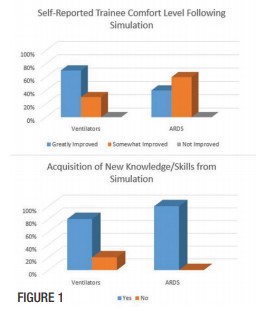Oregon Health & Science University
Portland, OR
Abstract Authors: Matthew D. Champion, MD; Jeffrey A. Gold, MD; Stephanie A. Nonas, MD
Program Director: Jeff A. Gold, MD
Type of Program: Pulmonary/Critical Care
BACKGROUND
Mechanical ventilation is an integral part of life-supportive care for critically ill patients. Numerous studies demonstrate significant underuse of lung protective (low tidal volume) ventilation. Failure to recognize the indications for lung protective ventilation and incorrect implementation of these practices may be due in part to inadequate training. Didactic-only curricula fall short in preparing trainees to identify changing respiratory physiology, such as air trapping, acute pneumothorax, or developing ARDS. Additionally, deliberate practice and assessment of trainees in mechanical ventilation is often limited by our inability to control the environment, patient mix, and concerns about patient safety. Simulation affords a unique educational opportunity for teaching and assessment. We have developed a simulation-based ventilation curriculum aimed at increasing our trainee readiness to manage mechanical ventilation.
METHODS
We identified gaps in practice related to ventilator management through direct assessment, faculty surveys, and chart review of adverse patient events. Based on these identified gaps, we developed a simulation-based curriculum consisting of baseline knowledge and skills assessment, brief introduction to the simulation environment, and three interactive high-fidelity sessions designed to mimic an ICU environment. The trainees progressively “manage” a simulated patient on a ventilator – from intubation to writing orders to responding to developing ARDS to managing ventilator emergencies. Each session contains three basic patient scenarios: 1) normal lungs, 2) obstructive lung disease, and 3) hypoxemic respiratory failure – each case with a built in ventilator “emergency” such as acute pneumothorax or mainstem intubation. Between cases there is a structured formative debrief to go over core concepts and interactive question/answer with the simulation leader. Following each session the trainees evaluate the usefulness of each scenario as well as their own comfort level in dealing with the scenario before and after the simulation.
RESULTS
15 critical care fellows (PGY 4-6) have participated in our simulations, including 7 fellows as part of their introductory “bootcamp.” The overall course evaluation for the ventilation/ARDS simulations was 4.83/5; ≥86% felt the course taught new information/ skills and 100% reported that training improved their comfort with ventilation/ARDS (Figure). We have validated our ventilator knowledge pre-test, and are now validating our skills and knowledge post-test.
DISCUSSION
High-fidelity simulation is a viable educational approach to allow deliberate practice surrounding mechanical ventilation. Our ongoing studies will determine the impact of training on clinical performance and we plan to expand our curriculum to the broader range of trainees and critical care practitioners at our institution.




